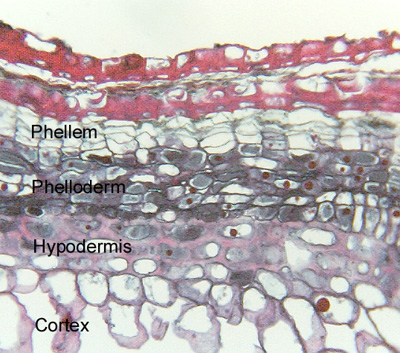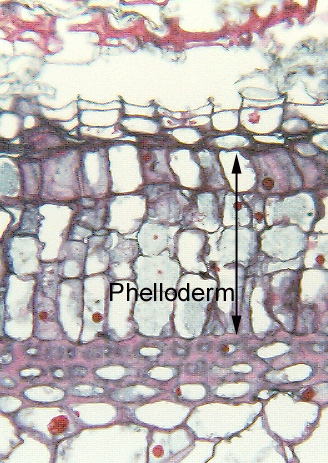 Fig.
17.1-5a and b. Transverse section. of
cactus bark (Acanthocereus sicariguensis). In
cacti, the cork cambium always arises from the epidermis: even though
the epidermis remains alive and functional as long as the stem is green
(hundreds of years in many species), when bark is needed, the epidermis cells
become mitotically active and act as the cork cambium. Although by this time the
epidermis cells have been vastly more long-lived than in any other group of
plants, as cork cambium cells, they must again be long-lived because they are
never replaced. Cacti form only this one cork cambium, new ones are not later
formed in the cortex or secondary phloem.
Fig.
17.1-5a and b. Transverse section. of
cactus bark (Acanthocereus sicariguensis). In
cacti, the cork cambium always arises from the epidermis: even though
the epidermis remains alive and functional as long as the stem is green
(hundreds of years in many species), when bark is needed, the epidermis cells
become mitotically active and act as the cork cambium. Although by this time the
epidermis cells have been vastly more long-lived than in any other group of
plants, as cork cambium cells, they must again be long-lived because they are
never replaced. Cacti form only this one cork cambium, new ones are not later
formed in the cortex or secondary phloem.
Because the cork cambium arises from
the epidermis, and because there is always a hypodermis just below the
epidermis, the hypodermis acts as a marker: in these micrographs you can see
that there are many cells between the cork cells and the hypodermis collenchyma
cells. These cells must be new cells (they could not possibly have existed
between the epidermis and the adjacent hypodermis). Such
new cells must be phelloderm. In the larger micrograph, the
phelloderm cells are radially elongate, almost columnar.